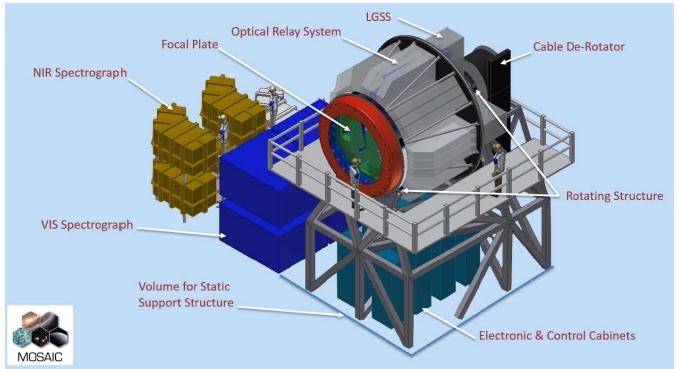MOSAIC at the ELT: A Gigantic Step into the Deep Universe
The MOSAIC multi-object spectrograph will be the workhorse instrument for the future Extremely Large Telescope (ELT), the biggest visible/infrared telescope in the world. It will be the world-leading multi-object spectrograph well into the 2020s, contributing to most fields of contemporary astronomy. Scientists from across the world are meeting in Toledo to explore the unprecedented capabilities of MOSAIC in tracking the earliest ‘first-light’ structures in the Universe, and to refine plans for observations that will uniquely trace the amounts of dark and invisible matter in the deep Universe (see video).

The MOSAIC team* is now finalising the design concept for a versatile multi-object spectrograph at the ELT. It will provide spectra of astronomical objects in both the visible and nearinfrared parts of the electromagnetic spectrum, using optical fibres to relay light from the telescope to an array of spectrographs. In addition to enabling observations of hundreds of objects simultaneously, it will provide a mode where several targets of particular interest can be observed at finer spatial resolution via correction from wide-field adaptive optics.
When combined with the world’s largest collecting area at these wavelengths, MOSAIC will be able to observe the tiny spectral features arising from cold, warm and hot gas in the halos of galaxies in the deep Universe, looking back some 12 billion years. Using advanced tools that take into account the properties of the astronomical objects, the effects of Earth’s atmosphere, and the performance of the telescope and the instrument, young scientists will show a suite of new simulations in Toledo, Spain. These will demonstrate how MOSAIC will obtain the first rotation curves of the most distant galaxies, allowing astronomers to test if their dark matter content was already in place, or has changed with time. Beyond this flagship case, MOSAIC on the ELT will also provide unique observations of the first galaxies and possibly the first generation of stars, the early formation of massive black holes, and numerous mysteries in the distant and nearby Universe.
Note :
(*) The MOSAIC Consortium includes five Leading Countries (France, the UK, the Netherlands, Brazil and Germany), and six Associated Partners (Austria, Finland, Italy, Portugal, Spain, and Sweden). The team includes François Hammer, Pascal Jagourel (Observatoire de Paris), Chris Evans (UK-ATC, Edinburgh), Mathieu Puech (Observatoire de Paris), Gavin Dalton (RAL & Oxford Univ.), Myriam Rodrigues (Observatoire de Paris), Ewan Fitzsimons (UK-ATC, Edinburgh), Simon Morris (Durham Univ.), Beatriz Barbuy (IAG, Sao Paulo), Jean-Gabriel Cuby (LAM, Marseille), Lex Kaper (Amsterdam Univ.), Martin Roth (AIP, Potsdam), Gérard Rousset (Observatoire de Paris), Richard Myers (Durham Univ.), Olivier Le Fèvre (LAM, Marseille), Alexis Finogenov (Helsinki Univ.), Bruno Castilho (LAN, Itajuba), Goran Ostlin (Stockholm Univ.), Jesus Gallego (Madrid, Computense Univ.), Iglesias-Paramo (IAA, Spain), Fabrizio Fiore (Roma Observatory), Bodo Ziegler (Vienna Univ.), Jose Afonso (Lisboa Univ.), Marc Dubbledam (Durham Univ.), Marc Close (Durham Univ.), Phil Parr Burman (UK-ATC), Tim Morris (Durham Univ.), Fanny Chemla (Observatoire de Paris), Fatima De Frondat (Observatoire de Paris), Andreas Kelz (AIP, Potsdam), Isabelle Guinouard (Observatoire de Paris), Ian Lewis (Oxford Univ.), Kevin Middleton (RALSPACE, Oxford), Ramon Navarro (NOVA), Marie Larrieu (IRAP, Toulouse), Johan Pragt (NOVA), Annemieke Janssen (NOVA), Kjetil Dohlen (LAM, Marseille), Kacem El Hadi (LAM, Marseille), Yanbin Yang (Observatoire de Paris), Sylvestre Taburet (Observatoire de Paris), Mickael Frotin (Observatoire de Paris), Claire Bouillet (Observatoire de Paris).
IRAP Contact
- Thierry Contini, thierry.contini@irap.omp.eu






